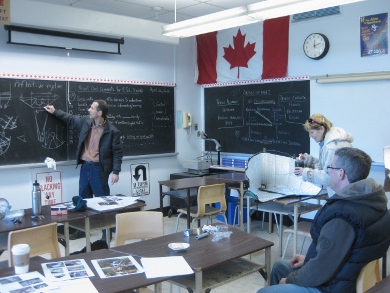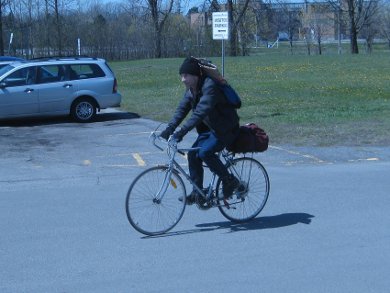This is a half-day long class I developed and that I teach. You are more than welcome to use it for the purpose of teaching your own courses. .PDF and .DOC files containing the course handout are below. I teach it through the Ottawa-Carleton District School Board's General Interest Program during the spring session.
|
|
The course handout
The following is the course handout:
- Solar Cooking course in a .PDF file: solar_cooking_april_2012.pdf
- Solar Cooking course in a .DOC file: solar_cooking_april_2012.doc
I had photocopying restrictions so there are no diagrams in the course notes. This means you'll either have to add some or do drawing on a blackboard or whiteboard.
I also give these plans for making a Modified CooKit with the handout:
The_Modified_CooKit_11Nov2011.pdf
But I do that because one of the solar cookers I use during the class is a Modified CooKit. I like it because it can be used with low and high sun angles, it's a panel cooker and so doesn't need a lot of adjustment while the sun moves, it folds up small enough to carry in a backpack (see photo below) and it's super easy to make and proves that anyone can make one. You can find more details on my Modified CooKit webpage.
I also printed out some color photos of different types of solar cookers to give to students.
|
Teacher's notes
The course took 3 hours and included time enough to warm up chilli using a Modified CooKit and cook carrots and celery in water using a car sunshade cooker. How you do things will be different since you'll use different cookers and have a different climate.
I highly recommend doing this course on a day when you can solar cook. To pick a date I did research on the web to find a date when historically there was more often full sunshine than not.
Try to have a classroom located close to a door for going outdoors to check on the solar cookers. If possible, arrange it so you can see the cookers from the classroom. If you can teach the class outdoors that's even better but in my case it was around freezing temperatures outdoors. Teaching it outdoors near the cookers also avoids the repetition of talking about stuff outdoors and then going indoors and talking about it again in the lecture.
I didn't have the students make a solar cooker because I didn't have sufficient transportation to bring materials. It would definitely add value for the students if they could make their own though. The Modified CooKit takes around 2 hours to build, in addition to the 3 hours mentioned above. If you choose that one then you can save a lot of time by bringing a template that can be traced out onto the cardboard rather than having to make measurements.
I started at 9:05am with introduction of myself, then the course contents and then the students instruduced themselves. Then I did the What is solar cooking, the Why cook with the sun and the What, when and where can you cook subsections. After that, around 9:30am, we went outdoors and got the cooking started. At that point I also explained a few things about setting it up such as how to line up the cookers with the sun.
At suitable times we checked on the cooking. By around 10:45am the chilli was ready and we ate. Around 11:45am, as the last part of the course the carrots and celery were ready so we ate those and wrapped up (the cooking jar for the carrots and celery were mismatched for the car sunshade cooker, too small, so they took long.)




